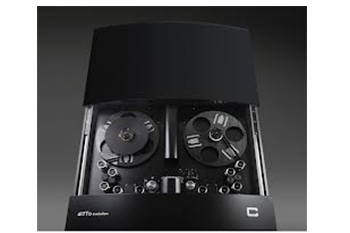
Film Conversion Equipment
Film Scanning and Film Transfer Equipment Types
The type of film scanning machine used for your 8mm, Super 8 or 16mm film conversion will have as much of an impact on the quality you receive as the resolution of the scan itself will. For example, if you wanted to digitize a photograph and tried doing it two different ways. You first put the photograph down on a table and took a picture of it using your smart phone or camera. Then you took the picture and scanned it using a flatbed scanner. If you compare the two side by side on your computer it will become really obvious that the flatbed scanner produced a digital image as good as the photograph. However, the picture you took with your phone or camera does not look close to the quality of the original photograph.
The same goes for scanning your 8mm, Super 8 or 16mm film. The real-time and frame by frame machines below are using a camcorder to take a picture of your film. The motion picture film scanner and Datacine machine are scanning the film. The results will be significantly different.
Film Conversion Equipment |
|
Real Time
|
|
Frame by Frame
|
|
Professional Film Scanners
|
|
The film transfer processes above are the basics types and do not include any restoration by themselves. Restoration comes in many different capabilities from color and exposure correction, to grain elimination, to stabilization
Bowie Fun Facts: The origins of Bowie trace back to 1870, when a community formed around a local railroad stop where the B&O Railroad tracks to Washington branched off from their main line. The railroad station was called Bowie in honor of local resident Governor Oden Bowie; however, the name of its surrounding town was Huntington City. Huntington City was incorporated as a town in 1874, but its charter was later amended to change the town's name to Bowie. In 1916, Bowie was incorporated and then re-incorporated as a city in 1963 after annexing the adjacent residential community of "Belair at Bowie", which had been developed by the firm of Levitt and Sons on the former Belair Estate, once a colonial plantation of Governor Samuel Ogle.
Maryland Fun Facts: Annapolis, the state capital, is also home to the United States Naval Academy. Maryland is the leading producer of blue crabs and is renowned for its crab cakes. One of the original 13 colonies, Maryland lies at the center of the Eastern Seaboard, amid the great commercial and population complex that stretches from Maine to Virginia. Its small size belies the great diversity of its landscapes and ways of life that they foster, from the low-lying and water-oriented Eastern Shore and Chesapeake Bay area, through the metropolitan Baltimore, its largest city, to the forested Appalachian foothills and mountains of its western reaches.








